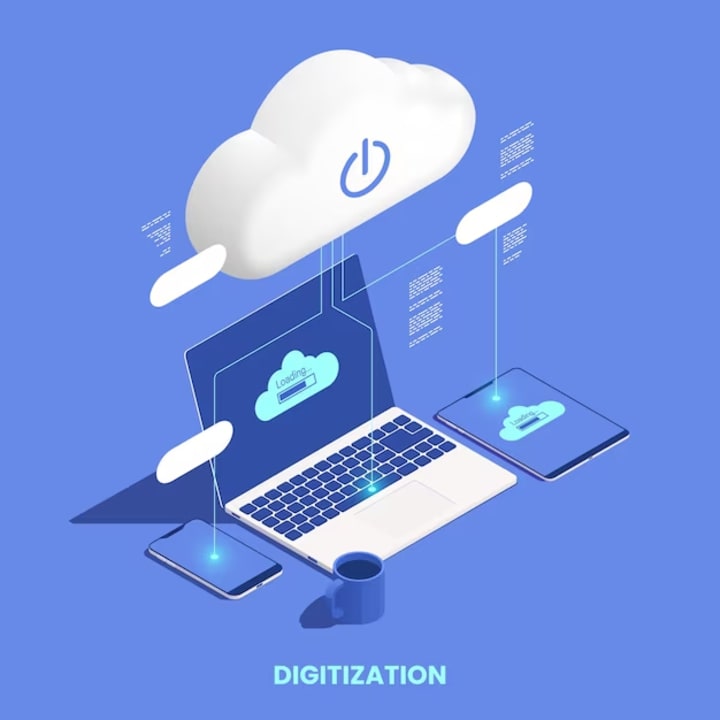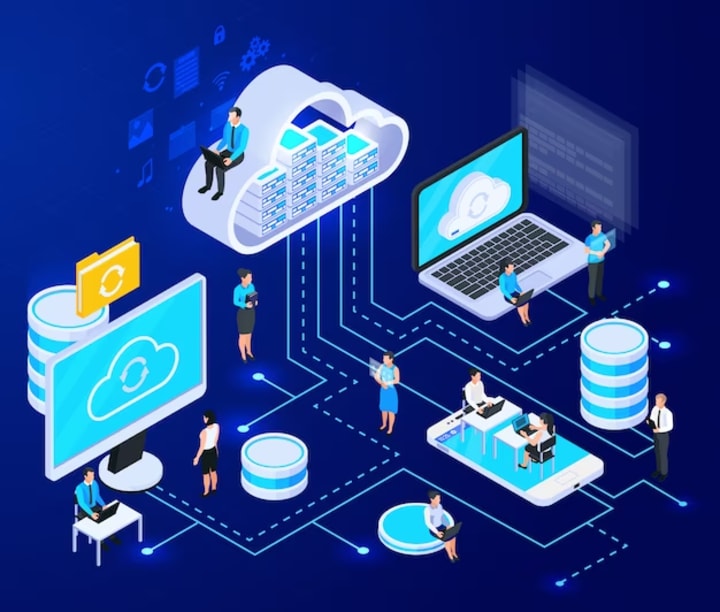The Cloud Computing Revolution: Examining its Rising Impact on the IT Industry
Cloud computing is the delivery of computing services over the internet, enabling users to access data, applications, and computing resources without having to invest in expensive hardware and software. These services include servers, storage, databases, networking, software, analytics, and intelligence. Cloud computing has become a popular choice for businesses and individuals alike, as it provides faster innovation, flexible resources, and economies of scale.

Cloud Computing: Everything You Need to Know
Cloud computing has revolutionized the way we store, access, and manage data. It has become an indispensable part of our digital lives, from accessing social media platforms to storing sensitive business data. This article aims to provide a comprehensive guide to cloud computing, from its definition to its history, benefits, and use cases.
What is Cloud Computing?

Cloud computing is the delivery of computing services over the internet, enabling users to access data, applications, and computing resources without having to invest in expensive hardware and software.
These services include servers, storage, databases, networking, software, analytics, and intelligence. Cloud computing has become a popular choice for businesses and individuals alike, as it provides faster innovation, flexible resources, and economies of scale.
Brief History of Cloud Computing:

The idea of cloud computing dates back to the 1960s, with the development of time-sharing, which allowed multiple users to access a single computer simultaneously.
The use of virtualization in the 1990s led to the development of modern cloud computing infrastructure. The term "cloud computing" was coined in 2006, and since then, cloud computing has evolved to become an integral part of our digital lives.
Benefits of Cloud Computing:

Cloud computing offers several benefits, including:
Cost savings: Cloud computing eliminates the need for expensive hardware and software, reducing IT infrastructure and maintenance costs.
Scalability: Cloud computing allows businesses to scale their IT infrastructure up or down as needed, providing flexibility and agility.
Accessibility: Cloud computing enables users to access their data and applications from anywhere, at any time, using any device with an internet connection.
Security: Cloud computing providers offer robust security measures to protect data from cyber threats.
Types of Cloud Computing:

Cloud computing can be divided into four main types:
Public Cloud: Public cloud computing services are offered by third-party providers, and users can access them over the internet. Examples include Amazon Web Services, Microsoft Azure, and Google Cloud Platform.
Private Cloud: Private cloud computing services are hosted on-premises or in a dedicated data center and are accessible only to authorized users.
Hybrid Cloud: Hybrid cloud computing services combine both public and private cloud services, allowing businesses to leverage the benefits of both.
Multi-Cloud: Multi-cloud computing services involve using multiple public cloud providers to meet specific business needs.
Use Cases of Cloud Computing:
Cloud computing has several use cases, including:
Data Storage and Backup: Cloud computing provides secure and reliable data storage and backup solutions, ensuring that data is protected and easily accessible.
Software Development and Testing: Cloud computing provides an efficient and cost-effective platform for software development and testing.
Disaster Recovery: Cloud computing enables businesses to recover from disasters quickly and efficiently, minimizing downtime and data loss.
Artificial Intelligence and Machine Learning: Cloud computing provides the computational power and storage needed for AI and ML applications.
Advantages and Disadvantages of cloud computing:
Cloud computing has become an integral part of our digital lives, providing several advantages and disadvantages. Here are some of the most significant advantages and disadvantages of cloud computing.
Advantages of Cloud Computing:
Cost Savings: Cloud computing eliminates the need for expensive hardware and software, reducing IT infrastructure and maintenance costs.
Scalability: Cloud computing allows businesses to scale their IT infrastructure up or down as needed, providing flexibility and agility.
Accessibility: Cloud computing enables users to access their data and applications from anywhere, at any time, using any device with an internet connection.
Efficiency: Cloud computing delivers faster and more accurate retrievals of applications and data, providing efficient recovery plans.
Collaboration: Cloud computing allows teams to work together seamlessly, sharing data and resources in real-time, regardless of their location.
Disadvantages of Cloud Computing:
Security Concerns: Cloud computing raises security concerns, as users have to rely on the cloud service provider's security measures to protect their data.
Technical Issues: Cloud technology is known to experience outages and other technical issues, despite high standards of maintenance.
Loss of Control: When moving services to the cloud, businesses hand over control of their data and applications to the cloud service provider, raising concerns about data privacy and ownership.
Performance Issues: When working in a cloud environment, applications may experience performance issues due to server sharing and resource allocation.
Vendor Lock-in: Switching cloud service providers can be difficult and expensive, as businesses have to reconfigure their applications and data to work with the new provider's platform.
Some examples of popular cloud computing services used by Businesses:
Here are some examples of popular cloud computing services used by businesses:
Amazon Web Services: Amazon Web Services (AWS) provides a wide range of cloud computing services, including compute, storage, databases, analytics, machine learning, and more. It is one of the most popular cloud platforms used by businesses.
Microsoft Azure: Microsoft Azure is another popular cloud platform that provides a wide range of cloud services, including compute, storage, databases, analytics, and more. It is widely used by businesses of all sizes.
Google Cloud Platform: Google Cloud Platform provides a wide range of cloud services, including compute, storage, databases, analytics, machine learning, and more. It is a popular choice for businesses that rely heavily on Google's services.
Salesforce: Salesforce is a cloud-based customer relationship management (CRM) platform that allows businesses to manage their customer relationships, sales, and marketing activities. It is widely used by businesses of all sizes.
Dropbox: Dropbox is a cloud-based file storage and collaboration platform that allows users to store, share, and access files from anywhere. It is widely used by businesses for file sharing and collaboration.
Zoom: Zoom is a cloud-based video conferencing platform that allows users to host virtual meetings, webinars, and other online events. It has become a popular choice for businesses that rely on remote work and virtual collaboration.
These are just a few examples of popular cloud computing services used by businesses. The choice of cloud service depends on the specific needs and requirements of each business, as well as their budget and expertise in managing cloud infrastructure.
Pricing models for cloud computing services:
There are several pricing models for cloud computing services. Here are some of the most common pricing models:
Pay-as-you-go model: This is the most commonly used type of cloud cost model, where businesses pay for the cloud services they use. This model is perfect for businesses with dynamic services.
Subscription-based model: This model allows businesses to pay a fixed amount for a specific period of time, such as a month or a year, and use the cloud services as much as they want within that period.
Hybrid pricing model: This model combines the pay-as-you-go and subscription-based models, allowing businesses to pay a fixed amount for a certain level of service, and then pay for additional services as needed.
Fixed pricing model: Some of the most famous cloud service providers, such as Google, Amazon Web Services, Oracle, and Azure, use fixed pricing models.
On-demand pricing: This model allows businesses to pay for the cloud services they use on an hourly basis. This model is suitable for businesses that need to use cloud services for short periods of time.
Spot pricing: This model allows businesses to bid on unused cloud capacity and get cloud services at a lower price. This model is suitable for businesses that can tolerate occasional interruptions in cloud service.
Reserved instance pricing: This model allows businesses to pay upfront for a certain amount of cloud capacity and get discounts on the cloud services they use. This model is suitable for businesses that need predictable cloud capacity for a longer period of time.
Volume discounts or tier-based pricing: This model allows businesses to get discounts on cloud services based on the volume of cloud services they use. This model is suitable for businesses that use a large amount of cloud services.
These are just a few examples of cloud computing pricing models. The choice of pricing model depends on the specific needs and requirements of each business, as well as their budget and usage patterns.
Conclusion:
Cloud computing has transformed the way we store, access, and manage data. It has become an essential part of our digital lives, providing faster innovation, flexible resources, and economies of scale. With the continued growth of cloud computing, businesses and individuals can expect to benefit from its many advantages in the years to come.





Comments
There are no comments for this story
Be the first to respond and start the conversation.